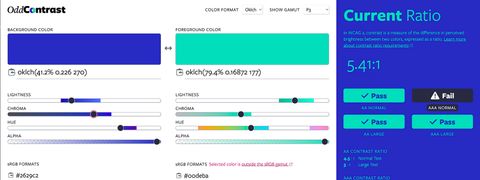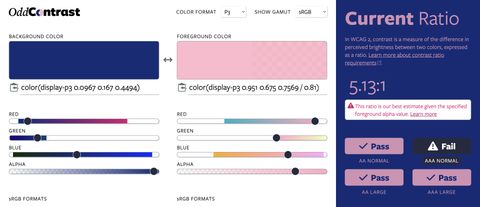Make the Web a More Colorful Place!
A guide to using new color spaces & formats with OddContrast
OddBird’s color tool not only checks contrast ratios, but supports the new CSS color formats and spaces.

Catching up to the spec
Our sponsors are supporting the continued development of the CSS Anchor Positioning Polyfill. Here’s a summary of the latest updates.
Check out our Winging It conversations about design, frontend, and backend development.
Winging It episode 8: CSS Anchor Positioning in Practice
Winging It episode 16: Debugging CSS Anchor Positioning
A few years ago, OddBird started working on a polyfill for CSS Anchor Positioning as the spec started to take form. Now that the spec has stabilized and Chromium has begun implementation, we are relying on our sponsors to support development of the polyfill. Thanks to their contributions, we’re releasing v0.1.0.
position-anchorIn their full form, anchor functions can be quite verbose and repetitive.
#target {
top: anchor(--my-anchor bottom);
width: anchor-size(--my-anchor width);
}position-anchor allows you to specify a default anchor for an element.
#target {
position-anchor: --my-anchor;
top: anchor(bottom);
width: anchor-size(width);
}You can also use this to share positioning rules while using different anchors. Both Target A and Target B will be positioned to the right of their anchor, but they will use different respective anchors.
.target {
left: anchor(right);
}
.target#a {
position-anchor: --anchor-a;
}
.target#b {
position-anchor: --anchor-b;
}position-anchor will also be useful for things like inset-area, which
isn’t yet supported by the polyfill.
Thanks to a great contribution from @ayoreis, the validity algorithm has been updated to match the spec. More can be found in the issue, but this change makes more elements available for anchoring. Notably, you can now anchor to another element that is anchored as well (as long as the anchor element is layed out before the target element).
anchor-name.In this example, both #target-a and #target-b are referring to the same
element, but with different names.
.anchor {
anchor-name: --a, --b;
}
#target-a {
position-anchor: --a;
}
#target-b {
position-anchor: --b;
}This will enable a number of use cases where a target can be anchored to
different anchors, depending on what is available. Perhaps some of your pages
have a different layout, where you want #target-b to anchor to a
#side-anchor if there is one, but otherwise to the default .anchor.
.anchor#side-anchor {
anchor-name: --b;
}Interested in learning more about anchor positioning? Sign up for our free weekly CSS anchor positioning email course.
While a lot of the basic functionality is already possible with the polyfill, there’s a lot left to do to bring the polyfill up to date with the spec. Our v1.0.0 Milestone is prioritized based on what we think will be the most impactful and useful features, and some of the upcoming ones are:
anchor-scopeinset-areaIf you’re as excited as I am to use these features, there are a few ways you can help. First, let us know which features you’re most eager to see supported by commenting on the GitHub issues. We also welcome PRs.
And of course, sponsoring OddBird’s Open Source work is a great way to help make our continued work on this polyfill (and others) possible. We’re grateful for our existing sponsors who have made this release possible, and you can see them below.
A huge thank you to the individuals and organizations sponsoring OddBird’s open source work!
We love contributing back to the languages & tools that developers rely on, from CSS & Sass to browser polyfills and Python. Help us keep that work sustainable and focused on developer needs!


A guide to using new color spaces & formats with OddContrast
OddBird’s color tool not only checks contrast ratios, but supports the new CSS color formats and spaces.

hint popovers, position-area and more
We have been busy updating the Popover and CSS Anchor Positioning Polyfills, but there is still more we can do with your help.

Display color gamut ranges and more
OddContrast, OddBird’s color format converter and contrast checker, gets new features – including the ability to swap background and foreground colors, and display color gamut ranges on the color sliders. Contrast ratios now incorporate foreground color alpha values.